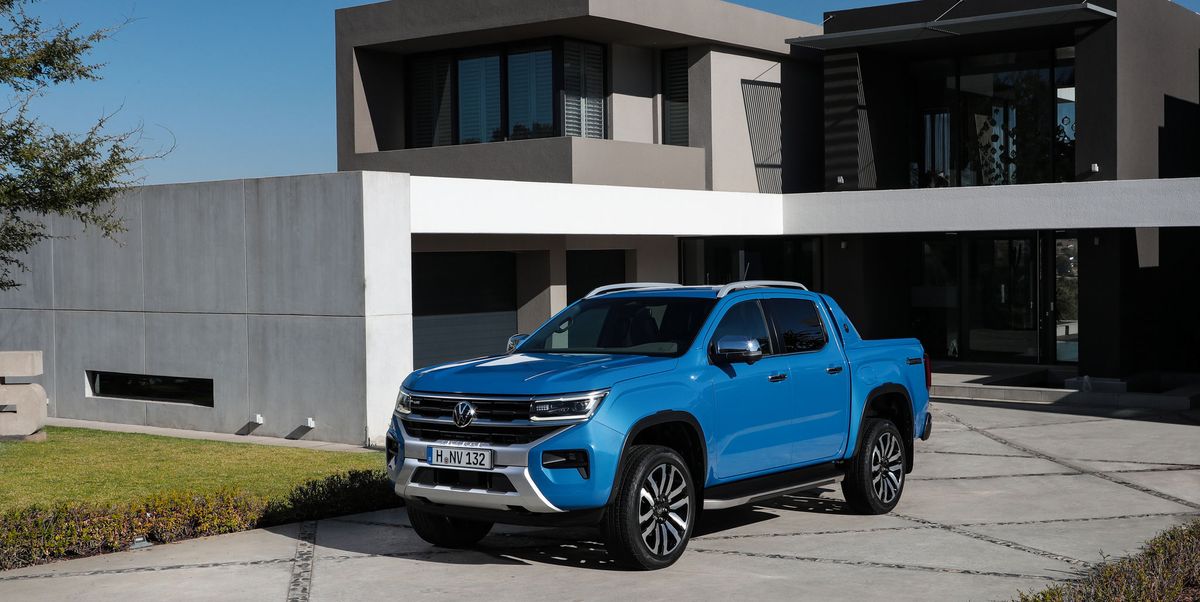VW's Reveals Amarok Pickup, a Small Gem That's Not U.S. Bound

The global debut of the VW Amarok reveals a mid-size pickup closely related to the next-gen Ford Ranger.It’s not destined for the U.S., with most sales expected in Australia, Europe, and Africa.It will offer a range of diesel engines including a V-6, plus a 298-hp gasoline turbo.
The thinking behind automotive product strategies often seems like a mystery to those on the outside looking in, and we’ve certainly never understood why Volkswagen chose not to bring the Amarok pickup to the market that buys more pickups than anywhere else in the world—the U.S.
Now Volkswagen is revealing a new second-generation Amarok, one that also seems set to be denied to us, despite the fact it shares its underpinnings with the Ford Ranger and was developed alongside it by teams working in Germany and Australia. The finished truck is set to be produced in South Africa, with Volkswagen saying it will be sold “in Australia and New Zealand, numerous countries of Africa, the Middle East, and Europe.” You’ll notice that no part of the Americas is on that list, despite the previous version having been offered in some Central American and South American markets.
So what are we missing out on? Although larger than its predecessor, the new Amarok would be regarded as a mid-size pickup if it were to reach the U.S. Overall length of 210.6 inches is 3.8 inches longer than the old Amarok but 0.8 inch shorter than the 2023 Ford Ranger. The new truck’s 128.7-inch wheelbase is, unsurprisingly, identical to that of the Ford. Both single- and double-cab versions will be offered, with the two-door having a cargo bed 90.7 inches long and the four-door having a 60.8-inch bed. Maximum width between wheel arches is 47.5 inches. Volkswagen says it will be able to carry up to 2550 pounds, depending on specification, and to tow up to 7700 pounds.
It should be pretty decent off-road, too. Shortened overhangs compared to the old Amarok have improved its ability to tackle a modest level of wilderness, with a 29-degree approach angle, 21-degree departure angle, and 21 degree ramp-over angle. Volkswagen also says it can safely pass through up to 31.5 inches of water—the same figure claim Ford makes for the next Ranger.
Powertrain Choices Mainly Diesel
Volkswagen is planning to offer a multitude of powertrain options. A basic rear-wheel-drive version combining a 147-hp 2.0-liter diesel engine and a five-speed manual gearbox will be offered in certain African markets, with a more powerful 167-hp version of the same engine being sold elsewhere with the choice of a six-speed manual or six-speed automatic transmission, together with either rear-wheel drive or selectable four-wheel drive. Beyond that, a twin-turbocharged diesel will make 200 horsepower and drive though what Volkswagen says is a permanent all-wheel-drive system—although with the ability to disconnect drive to the front for improved economy—while working with either the six-speed auto or a 10-speed auto that is the Ford/GM gearbox. In other countries a slightly more powerful 203-hp version of this engine will get selectable four-wheel drive and the 10-speed gearbox.
Beyond this, Volkswagen will continue to offer the option of its long-serving 3.0-liter V-6 diesel. That’s a developed version of the one fitted to the previous-generation Amarok we drove in Europe in 2018. This makes 246 hp and 440 pound-feet of torque and gets the 10-speed auto and AWD as standard. Volkswagen will also offer a gasoline engine in some markets, although non-diesel pickups are still a rarity in Europe. It’s seemingly Ford’s 2.3-liter EcoBoost four-cylinder making 298 hp and 333 pound-feet, and again shipping with the 10-speed and permanent AWD.
Volkswagen will sell the Amarok in a wide variety of grades reflecting its use as both a utility and a lifestyle truck. Even the most basic versions will have digital instruments, a 10-inch portrait-oriented touchscreen, LED headlights, and adaptive cruise control. At the top of the range, the much plusher PanAmericana and Aventura will add such luxuries as a bigger 12-inch display screen, Harman/Kardon audio systems, soft-touch cabin materials (described as “leather look” rather than leather), and even 21-inch alloy wheels.
While the Ranger and Amarok have many shared components, including column stalks, the autobox gear selector, and various bits of minor switchgear, there are substantive changes, too, such as different dashboards. The Amarok follows the example of other recent Volkswagens by having temperature and climate control through its touchscreen; the Ranger keeps physical function buttons.
Why will we be denied it? Beyond the difficulty faced by automakers outside the big three selling trucks in the U.S., pricing seems to be the big issue: the previous Amarok started at the equivalent of over $40,000 in Europe. Yet the fact the closely related fifth-generation Ford Ranger is set to be sold here does leave the door open. We still love the idea of a Volkswagen Truck.
This content is imported from {embed-name}. You may be able to find the same content in another format, or you may be able to find more information, at their web site.
This content is created and maintained by a third party, and imported onto this page to help users provide their email addresses. You may be able to find more information about this and similar content at piano.io



